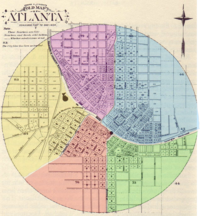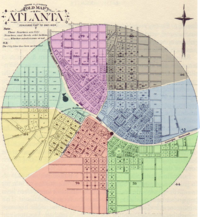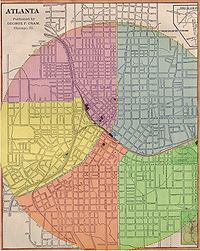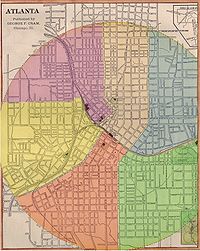.gif)
Fifth Ward (Atlanta)
Encyclopedia
Atlanta's Fifth Ward encompassed mainly what is now the part of downtown and midtown between the west side of Peachtree and the Western and Atlantic Railroad
.
 The 1848 charter only specified election of six city-wide councilmembers, but on January 9, 1854 an ordinance was adopted that divided the town into five wards and two councilmen from each ward would be elected to coincide with the completion of the first official city hall.
The 1848 charter only specified election of six city-wide councilmembers, but on January 9, 1854 an ordinance was adopted that divided the town into five wards and two councilmen from each ward would be elected to coincide with the completion of the first official city hall.
The next election with the new rules on January 15, 1855 decided those first Ward bosses who would serve with the short-term mayor, Allison Nelson
. The Fifth Ward was laid out west of Ivy and north of A&W Railroad. This ward contained the large homes along Peachtree Street
and the southern part, Fairlie-Poplar
was also largely residential with warehousing along the western part.
 During a huge boom of post-war building, two new wards were added from parts of the First, Fourth and Fifth to reflect the changing look of the city. This would be the layout until the city limits were expanded in 1874.
During a huge boom of post-war building, two new wards were added from parts of the First, Fourth and Fifth to reflect the changing look of the city. This would be the layout until the city limits were expanded in 1874.
Parts of the Fourth and Fifth Wards were taken to form a Seventh Ward (grey) established on December 2, 1871. Specifically from the "junction of Houston and Pryor streets, thence through lot nineteen, between blocks three, one and two, five and six, to the city limits; thence northerly along the city limits to Peachtree Street; thence south along Peachtree Street and Pryor Street to the beginning." And the Fourth was extended "from Ivy Street west to Pryor, and from Houston Street south to the railroad, and that Pryor Street shall be the line between the fourth and fifth wards, and Pryor and Peachtree streets between the fifth and seventh wards." This gave the red-light district to the Fourth and created a new Ward of mostly farmers and to the west, fine residences along Ivy and the east side of Peachtree.
 A new city charter increased the radius of the city from one to one and a half miles, reduced the number of wards
A new city charter increased the radius of the city from one to one and a half miles, reduced the number of wards
back to five and created a bicameral council of two councilmen from each ward and a second body of three at-large aldermen was established.
The new Fifth ward layout was from Pryor and tracks north-east to Peachtree, then West Peachtree to city limits, south-west to Foundry and W&A RR and east to origin. Two councilmen would be elected from each ward each year.
In late 1875, an ordinance passed where each year one councilman would be elected from each ward for a two-year term. The first year, 1876 just had one city-wide alderman and a single councilman from each ward, and they would be fully staffed two years later.
 On November 5, 1883 a Sixth Ward (beige) was carved out of the Fourth and Fifth Wards. In later years wards were added or modified to handle newly annexed parts of the city but the Fifth remained essentially unchanged. The city converted to a district system in 1954.
On November 5, 1883 a Sixth Ward (beige) was carved out of the Fourth and Fifth Wards. In later years wards were added or modified to handle newly annexed parts of the city but the Fifth remained essentially unchanged. The city converted to a district system in 1954.
Western and Atlantic Railroad
The Western and Atlantic Railroad of the State of Georgia' is a historic railroad that operated in the southeastern United States from Atlanta, Georgia to Chattanooga, Tennessee....
.
1854

The next election with the new rules on January 15, 1855 decided those first Ward bosses who would serve with the short-term mayor, Allison Nelson
Allison Nelson
Allison Nelson was the ninth mayor of Atlanta, Georgia, as well as a brigadier general in the Confederate army during the American Civil War....
. The Fifth Ward was laid out west of Ivy and north of A&W Railroad. This ward contained the large homes along Peachtree Street
Peachtree Street
Peachtree Street is the main street of Atlanta. The city grew up around the street, and many of its historical and municipal buildings are or were located along it...
and the southern part, Fairlie-Poplar
Fairlie-Poplar
The Fairlie-Poplar Historic District is part of the central business district in downtown Atlanta. It is named for the two streets that cross at its center, northeast-only Fairlie and southeast-only Poplar. Fairlie-Poplar is immediately north of Five Points, the definitive centerpoint and...
was also largely residential with warehousing along the western part.
1871

Parts of the Fourth and Fifth Wards were taken to form a Seventh Ward (grey) established on December 2, 1871. Specifically from the "junction of Houston and Pryor streets, thence through lot nineteen, between blocks three, one and two, five and six, to the city limits; thence northerly along the city limits to Peachtree Street; thence south along Peachtree Street and Pryor Street to the beginning." And the Fourth was extended "from Ivy Street west to Pryor, and from Houston Street south to the railroad, and that Pryor Street shall be the line between the fourth and fifth wards, and Pryor and Peachtree streets between the fifth and seventh wards." This gave the red-light district to the Fourth and created a new Ward of mostly farmers and to the west, fine residences along Ivy and the east side of Peachtree.
1874

Atlanta ward system
From its incorporation in 1848, the municipal boundaries Atlanta, Georgia were extended repeatedly from a small area around its railroad station to today's city covering .Prior to 1954, Atlanta was divided into political divisions called wards...
back to five and created a bicameral council of two councilmen from each ward and a second body of three at-large aldermen was established.
The new Fifth ward layout was from Pryor and tracks north-east to Peachtree, then West Peachtree to city limits, south-west to Foundry and W&A RR and east to origin. Two councilmen would be elected from each ward each year.
In late 1875, an ordinance passed where each year one councilman would be elected from each ward for a two-year term. The first year, 1876 just had one city-wide alderman and a single councilman from each ward, and they would be fully staffed two years later.
1883


